Hail on seedlings
Hail early in the season rarely has an impact on canola yield potential. If hail breaks off both cotyledons or snaps the stem, these plants usually do not survive. But while individual plants may die, a whole canola crop is fairly resilient to early-season hail when it comes to overall yield potential.
The crop maintains yield potential because the remaining seedlings take advantage of the reduced competition for light, moisture and nutrients. As a result, plants grow larger, produce more branches, and develop more pods and seeds per pod. However, with fewer plants, crop maturity can be delayed, and maturity throughout the field can be more variable between hailed and undamaged plants.
Instead of making a quick decision to reseed, walk the field, identify the best and worst areas of the field, and flag some individual plants to check back in a few days. In the meantime, get a hail insurance assessment.
A case study from Alberta. In mid-June 2020, a couple of massive heavy hailstorms flattened canola fields around Calgary. A CCC agronomy specialist walked a field the day after the hail and flagged a few plants. Ten days later, the agronomy specialist returned to the same fields to check the flagged plants. Most plants killed in the hail were gone 10 days later. (They dried up.) The remaining seedlings were defoliated, but survived because they had with intact growing points. The plant stand ranged from 10 to 50 plants per square metre (one to five per square foot). Weeds growth was a challenge in some areas, but re-seeding likely would not be economical. In mid June, reseeding is higher risk, even though hail damage will likely delay maturity.
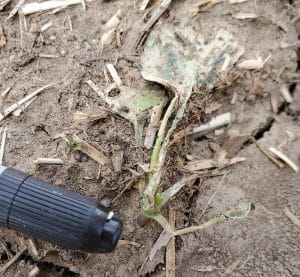
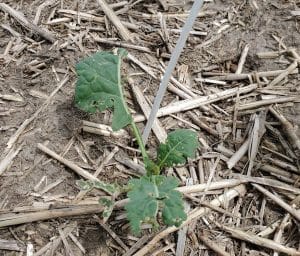
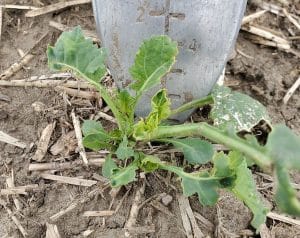
Fungicide can help at this stage if blackleg risk is high. Canola damaged early in the season can be susceptible to increased blackleg infections. Fungicide might help, but use it only if you were considering using it in the first place. If the field was already at high risk of blackleg, hail damage increases that risk. If blackleg was not a major risk, a fungicide application probably won’t help much or you won’t see a return on investment. Blackleg lesions (small, beige lesions with black pycnidia) on leaves or pseudothecia/ pycnidia on canola residue are indicators of risk. More on fungicide for blackleg.
Hail on 4- to 6-leaf plants
The later hail occurs, the higher the chance of yield loss – given that the plants have less time to recover. Plants at the 6-leaf stage that lose most of the leaf area on the main stem can still live, but these leaves will not regrow. Leaf area will come from new growth. The plant will be delayed, and more of the yield potential — which will be lower than before the hail — will come from side branches.
Hail at flowering
Flowering canola can, with enough time, recover from hail that knocks off a large percentage of flowers. Canola will flower for longer to compensate. In light hail, canola can sometimes over-compensate and produce even higher yield. In serious hail situations where entire flowering branches are knocked off, plants that are still actively flowering can produce new branches. This will set back maturity, but with enough season left, these new branches can produce a decent yield.
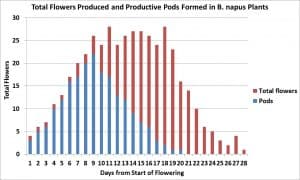
The point of no return. We assume there will eventually be a “point of no return” where the plant will no longer try to produce flowers, but we don’t know when that is. With moisture at harvest, we have seen regrowth start from cut stems, but we don’t know whether regrowth can occur from standing stems that are moving toward maturity. “Re-flowering”, or the production of side branches which then flower, will be less likely as the plant continues to develop to maturity.
Hail on pods
With flowering over, damage to pods and loss of pods from hail will mean irrecoverable yield loss. Plants mowed down can start to regrow, but they would take a couple of months to reach maturity again. This isn’t likely to happen before a killing frost.
Shattering risk increases for pods hit by hail. (Pod-shatter-tolerant canola can be more resilient to hail.) Before jumping the gun and swathing too early, take these decision-making steps:
- Assess where most of the crop yield will come from. If most of the yield will come from undamaged pods lower in the canopy, swathing after 60 per cent seed colour change (SCC) when those pods have reached full size will probably contribute more to yield than swathing early to save hail damaged pods. Note that hail tends to damage top pods more than lower pods, and top pods make a much lower contribution to yield.
- After hail on podded canola, increase crop walks for the following week to check lower pods. Damage to these lower pods may not be evident immediately after a hail, but bruises can show up after a few days. Seeds either side of a pod bruise will likely dry up, and bruised pods are more likely to shatter prematurely. If lower pods – pods where the yield is – have high levels of damage, then earlier swathing may be warranted.
- Be prepared to swath quickly if pod bruising is widespread. However, swathing before 20 per cent seed colour change is counterproductive.
Swathing crop that is uneven due to hail earlier in the season: Hail damage can cause crops to mature unevenly. Judging when to swath multi-stage crops can be tricky. If the field has distinct late and early parts, the two parts could be swathed at different times. If not, then make the swath decision based on the stage of those plants that will contribute most to yield. For example, if some plants are at 60 per cent SCC on the main stem and other plants are still flowering, growers may want to hold off on swathing. Or if plants are large with many secondary stems, the main stem may be at 60 per cent SCC, but seeds in side branches are still mushy and green. These seeds would wither up and amount to nothing if the crop is swathed at that stage.
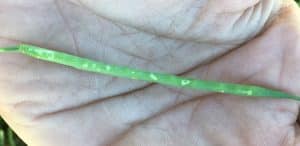
Rescue treatments for hail
Time and moisture are the best treatments. With time and moisture, a canola crop will do its best to recover from hail damage.
Fungicide for blackleg. Hail damage can provide an entry point for blackleg, but fungicide only provides a return on investment if blackleg infection occurs on very young plants (around the two-leaf stage).
Fungicide for sclerotinia stem rot. A hail study in Alberta showed a response to fungicide applied once the flowering resumed AND when the crop recovered enough to have good yield potential. This response may have occurred because moisture that came with the hail increased sclerotinia spore release and canopy moisture. In Ultimate Canola Challenge (UCC) nitrogen trials, one site that responded to extra nitrogen was a hailed site. But that nitrogen was put in place earlier in the season. The response likely occurred because the crop needed the extra nitrogen to rebuild biomass lost to hail.
Fertilizer. A top dress of nitrogen fertilizer may compensate for nitrogen lost through hail-shredded leaves, but keep in mind that the yield potential of the crop is also lower – so the question is how much more should one invest in this crop? If the plan was to top dress prior to the storm, then continue with that plan. Adequate nutrient availability still might be the most limiting factor to yield, especially if the soil moisture is improved following the storm.
Back in 2014, Canola Watch had a reader ask about foliar fertilizer after a hail storm. He had 2” of rain a week after a hailstorm and the grower felt that a foliar application could be worthwhile. The hail hit canola at the 5-6 leaf stage with a lot of main stem breakage. The grower asked for any other information on hailed canola and what he can do to help it recover.
We reached out to a few crop nutrition experts, and here are the answers we got:
- “Normally when I consider hail effects on canola, increased susceptibility to attack by disease, insects and possible need for pesticide application first comes to mind as priority consideration. As for nutritional effects, above-ground foliar injury by hail would seem to be a lesser issue compared to something for example that directly affects the roots — such as mechanical injury from tillage, herbicide pruning, insect feeding, disease. I cannot think of what major benefit a foliar application of a fertilizer nutrient could specifically provide, apart from providing some nutrient to enter into the foliage to replace that which was in leaves that were shredded and ended up on the ground. I also become concerned about fertilizer burn from foliar applied N sprays at high rates. So many variables – N status prior to injury, crop stage of injury, nature and extent of damage (broken stems vs leaf shredding etc) – affect the potential response and economic benefit. Especially given the uncertainty as to what one will eventually end up with after an early storm (I have personally been through this a few times), a foliar application of fertilizer on a hailed crop is not what I would choose as a priority spending of my crop input dollars.”
- “It is not inconceivable to get a response if hail knocked off a lot of leafs. Added nitrogen could stimulate leaf regrowth, but only if nitrogen is lacking and the crop has decent yield potential. Other questions are, will you have the moisture to stimulate late season growth? Do you have the time in the season to mature the crop? If yes, could get a yield benefit.”
- “We don’t have a lot of research on this because it is tough to do a controlled application of hail. There are also so many variables. What percentage yield loss occurred from the hail? What do they think the yield potential is now? How much N was applied before? Do they think the rain is building yield potential, or leaching/denitrifying N? What is the field texture? Considering that hail is likely to set the crop back considerably, do they think they will harvest it without freezing? Canola recovery from hail can be interesting. We had hail a couple of times at early flowering where it was crop adjusted at 90-100 per cent loss, but came back to yield over 35 bu./ac., so the crop can bounce better than you’d think. We also had slightly later hail that left us with no yield. So sometimes you have no recovery.”
- “Unless they had severely shorted their initial application of nitrogen and were still expecting excellent yields, I would not expect any specific benefit of foliar applications after a hailstorm.”
Leave check strips. When applying a rescue treatment, leave multiple check strips and compare yields for treated and untreated strips. Given the spotty nature of hail, using one strip or applying treatment to half the field may not provide an accurate comparison.
